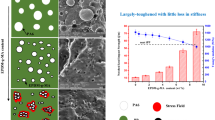Abstract
Hygroscopic aging causes swelling, degradation of mechanical and interfacial properties in thermosetting epoxy polymers, which eventually lead to a fast fracture at the interface in nanocomposite. Since the epoxy is a widely used high performance thermoset polymer for aerospace structures, durability analysis is necessary for the sake of maintenance and stability of the structures. In this study, the hygroelastic behavior of pure epoxy and epoxy/graphene nanocomposite is investigated through atomistic molecular dynamics (MD) simulation. To determine the hygroelastic behavior of epoxy materials, amorphous molecular unit cells of pure epoxy and epoxy/graphene nanocomposites with its highest possible cross-linking ratio and moisture contents of 0 and 2 wt% are considered. Through the classical ensemble simulations, diffusion coefficient of water in matrix, coefficient of moisture expansion (CME) and elastic modulus of pure epoxy and epoxy/graphene nanocomposites are determined.
Similar content being viewed by others
References
P. Mohan, A critical review: The modification, properties, and applications of epoxy resins, Polymer–Plastics Technology and Engineering, 52 (2) (2013) 107–125.
R. J. Morgan and J. E. O’neal, The durability of epoxies, Polymer–Plastics Technology and Engineering, 10 (1) (1978) 49–116.
R. P. Singh, M. Khait, S. C. Zunjarrao, C. S. Korach and G. Pandey, Environmental degradation and durability of epoxyclay nanocomposites, Journal of Nanomaterials, 2010 (352746) (2010).
S. Yu, A Study of thermal transport and mechanical properties of epoxy nanocomposties considering the cross–linking effect and the hygrothermal effect, Ph.D Thesis, Seoul National University (2013).
Y. Li, Atomistic modeling of environmental aging of epoxy resins, Ph.D Thesis, Georgia Institute of Technology (2012).
W. W. Wright, The effect of diffusion of water into epoxy resins and their carbon–fibre reinforced composites, Composites, 12 (3) (1981) 201–205.
R. J. Morgan, J. O’Neal and D. L. Fanter, The effect of moisture on the physical and mechanical integrity of epoxies, Journal of Materials Science, 15 (3) (1980) 751–764.
L. H. Tam and D. Lau, Moisture effect on the mechanical and interfacial properties of epoxy–bonded material system: An atomistic and experimental investigation, Polymer, 57 (2015) 132–142.
K. Imielinska and L. Guillaumat, The effect of water immersion ageing on low–velocity impact behavior of woven aramid glass fibre/epoxy composites, Composites Science and Technology, 62 (13–14) (2004) 2271–2278.
A. C. Loos and G. S. Springer, Moisture absorption of graphite–epoxy composties, immersed in liquids and humid air, Journal of Compostie Materials, 13 (2) (1979) 131–147.
J. Zhou and J. P. Lucas, Hygrothermal effects of epoxy resin. Part I: The nature of water in epoxy, Polymer, 40 (20) (1999) 5505–5512.
J. Zhou and J. P. Lucas, Hygrothermal effects of epoxy resin. Part II: variations of glass transition temperature, Polymer, 40 (20) (1999) 5513–5522.
D. A. Powers, Interaction of Water with Epoxy, Sandia report, SAND2009–4405 (2009).
A. Apicella, R. Tesseieri and C. D. Cataldis, Sorption modes of water in glassy epoxies, Journal of Membrane Science, 18 (1984) 211–225.
H. G. Lee, H. Kwon, S. Y. Park and W. J. Choi, Property evaluation of aerospace–grade composite laminate subjected to moisture absorption environments, KSAS (2011) 821–826.
Accelrys Inc., San Francisco, http://accelrys.com.
H. B. Fan and M. M. F. Yuen, Material properties of the cross–linked epoxy resin compound predicted by molecular dynamics simulation, Polymer, 48 (7) (2007) 2174–2178.
M. P. Allen and D. J. Tildesley, Computer Simulation of Liquids, Claren Press Oxford (1987) 156–158.
V. Varshney, S. S. Patnaik, A. K. Roy and B. L. Farmer, A molecular dynamics study of epoxy–based networks: Crosslinking procedure and prediction of molecular and material properties, Macromolecules, 41 (18) (2008) 6837–6842.
P. H. Lin and R. Khare, Molecular simulation of crosslinked epoxy and Epoxy–POSS nanocomposite, Macromolecules, 42 (12) (2009) 4319–4327.
C. Li and A. Strachan, Molecular simulations of crosslinking process of thermosetting polymers, Polymer, 51 (25) (2010) 6058–6070.
A. Shokuhfar and B. Arab, The effect of cross linking density on the mechanical properties and structure of the epoxy polymers: molecular dynamics simulation, Journal of Molecular Modeling, 19 (9) (2013) 3719–3731.
S. Masoumi, B. Arab and H. Valipour, A study of thermomechanical properties of the cross–linked epoxy: An atomistic simulation, Polymer, 70 (23) (2015) 351–360.
W. G. Hoover, Canonical dynamics: Equilibrium phasespace distributions, Physical Review A, 31 (3) (1985) 1695–1697.
W. G. Hoover, Constant–pressure equations of motion, Physical Review A, 34 (3) (1986) 2499–2500.
D. A. McQuarrie, Statistical Mechanics, University of Science Books (2000).
S. Plimpton, Fast parallel algorithms for short–range molecular dynamics, Journal of Computational Physics, 117 (1) (1995) 1–19.
S. H. Chang and H. S. Kim, Investigation of hygroscopic properties in electronic packages using molecular dynamics simulation, Polymer, 52 (15) (2011) 3437–3442.
S. G. Lee, S. S. Jang, J. Kim and G. Kim, Distribution and diffusion of water in epoxy molding compound: Molecular dynamics simulation approach, IEEE Transactions on Advanced Packaging, 33 (2) (2010) 333–339.
S. Masoumi and H. Valipour, Effects of moisture exposure on the crosslinked epoxy system: an atomistic study, Modelling and Simulation in Materials Science and Engineering, 24 (3) (2016) 035011.
S. S. Jang and W. A. Goddard III, Structures and transport properties of hydrated water–soluble dendrimer–grafted polymer membranes for application to polymer electrolyte membrane fuel cells: Classical molecular dynamics approach, The Journal of Physical Chemistry C, 111 (6) (2007) 2759–2769.
Author information
Authors and Affiliations
Corresponding author
Additional information
Recommended by Associate Editor Heung Soo Kim
Sunyong Kwon received bachelor degree of engineering and chemistry at Chung-Ang University, Korea in 2017. She is currently a master degree student of the graduate school of engineering at Chung-Ang University. Her research interests are molecular modeling of multifunctional nanocomposites for long time durability.
Seunghwa Yang is an Assistant Professor at Chung-Ang University, Seoul, Korea, since 2015. He received doctoral degree of mechanical engineering at Seoul National University in 2011. His major research fields are atomistic modeling of soft materials, sequential multiscale modeling of multifunctional composites, nanocarbon defect engineering, and micromechanics.
Rights and permissions
About this article
Cite this article
Kwon, S., Lee, M.Y. & Yang, S. Molecular dynamics approach on the hygroelastic behavior of epoxy/graphene nanocomposites. J Mech Sci Technol 33, 741–747 (2019). https://doi.org/10.1007/s12206-019-0128-1
Received:
Revised:
Accepted:
Published:
Issue Date:
DOI: https://doi.org/10.1007/s12206-019-0128-1




